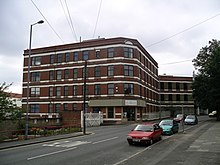Radford, Coventry
| Radford | ||
|---|---|---|
Metropolitan county | ||
| Region | ||
| Country | England | |
| Sovereign state | United Kingdom | |
| Post town | COVENTRY | |
| Postcode district | CV6 | |
| Dialling code | 024 or 025 | |
| Police | West Midlands | |
| Fire | West Midlands | |
| Ambulance | West Midlands | |
| UK Parliament | ||

Radford is a suburb and
Geography
Radford ward is bounded by Holbrooks, Foleshill, St Michael's, Sherbourne, and Bablake wards. It is covered by the North East Neighbourhood Management area.[2] It covers an area of 303.9 hectares.[3]
Radford consists of four neighbourhoods; Radford Diamond, East Radford, West Radford, and Canal Basin. Radford Diamond is located approximately one mile to the northwest of Coventry city centre and is bounded by Barkers Butts Lane, Lawrence Saunders Road and the Radford Road with the Coventry-Nuneaton railway forming the southern boundary. East Radford is a small neighbourhood consisting of six streets of densely populated housing: Newfield Road, Dorset Road, Somerset Road, Widdrington Road, Kingfield Road and Aldbourne Road. The Coventry-Nuneaton railway bounds the area on one side whilst the Coventry Canal bounds the other. West Radford is a large neighbourhood with a population of approximately 3,800, located approximately two miles north of the city centre. The Jubilee Crescent area, the area around St. Augustine's School and the Beake Avenue/Radford Road area are the three distinct parts to the neighbourhood. The Canal Basin neighbourhood comprises Leicester Row, St Nicholas Street, St Columba's Close and the Draper's Field development.[4]
History
At the end of the 19th century, Radford was turning from a largely undeveloped rural area into one of Coventry's major manufacturing areas. The southern area of Radford benefited from the presence of the
Possibly Radford's greatest historical claim to fame comes from its centrality in the birth of the British motor car industry.
Between the world wars, and for a short time only, Radford was home to an aerodrome situated close to the Daimler factory, the site of which is now taken by Joseph Cash Primary School and the Coventrians RFC.

During the "
Demographics
At the time of the
Places of interest
Radford is bordered on its western side by Radford Road, a main thoroughfare into Coventry city centre which extends out of Coventry to the areas of
Most of the northern area of Radford is residential, following development during the 20th century. Properties range from blocks of flats to semi-detached and terraced housing, and includes both privately owner-occupied properties and
Although Radford has endured the closure of many of its key employers in recent years, regeneration efforts are easily visible. The site of Radford railway station has been developed into a block of flats; Sandy Lane Power Station, which became offices for the East Midlands Electricity Board, has been redeveloped into Electric Wharf, a mixed-use site incorporating residential buildings and public art; and the former Daimler works are now a residential area known as Daimler Green.
Radford also benefits from a generous number of parks including Nauls' Mill Park that runs behind the Radford "Council" Estate (including Hewitt Avenue) and from Bridgeman Road through to Middleborough Road towards the back of Radford Fire Station bordering the City Centre. A little known fact is that, below ground, the busy, culverted, Radford Brook river runs and by one branch once filled the Nauls' Mill Park pool before joining the River Sherbourne under the
Education
Barr's Hill School is the coeducational comprehensive secondary school in the area. It was an all-girls grammar school until the 1970s (approx date). Primary schools in the area include Radford Primary Academy, Hill Farm School, St Augustine's RC Primary School, and Joseph Cash Primary School.
Military
Westfield House Army Reserve Centre, on Radford Road, currently houses Army Reserve detachments of the
Famous residents
Philip Larkin, widely regarded as one of the greatest English poets of the latter half of the twentieth century, was born in Radford at 2, Poultney Road.[8]
Another former resident of Radford was England boxer Errol Christie who went on to be European champion in the 1980s and a regular fixture on ITV Fight Night.
References
- ^ "Coventry Ward population 2011". Neighbourhood Statistics. Office for National Statistics. Retrieved 17 December 2015.
- ^ "Radford Ward". Coventry City Council. Archived from the original on 9 December 2007. Retrieved 11 May 2008.
- ^ a b "Radford in numbers". Coventry City Council. Archived from the original on 13 May 2007. Retrieved 11 May 2008.
- ^ "About Radford Ward". Coventry City Council. Archived from the original on 13 May 2007. Retrieved 11 May 2008.
- ^ a b c City planning services, Coventry City Council (1 March 1995). Coventry Car Factories: A centenary Guide. Industrial Press. p. 3.
- ^ "St Nicholas Church". St Nicholas Center. Retrieved 11 May 2008.
- ^ Nicholson, Jean et al: The Obelisks of Warwickshire, page 54. Brewin Books, 2013
- ^ "Philip Larkin © Orlando Project". Orlando.cambridge.org. 2 December 1985. Retrieved 17 April 2016.
- McGrory, David (1991): Around Coventry in Old Photographs, Sutton Publishing, ISBN 0-7509-3025-X.
